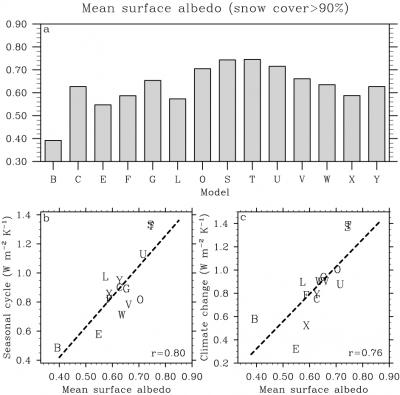The Spread in Snow-albedo Feedback Has Not Narrowed in the CMIP5 Ensemble
Snow-albedo feedback (SAF) enhances climatic anomalies in Northern Hemisphere (NH) land masses because of two changes in the snowpack as surface air temperature (Ts) increases. First, snow cover shrinks, and where it does it generally reveals a land surface that is much less reflective of solar radiation. Second, the remaining snow generally has a lower albedo due to snow metamorphosis. Previous studies demonstrate that the strength of SAF exhibited a threefold spread across climate change simulations participating in the Coupled Model Intercomparison Project version 3 (CMIP3). This spread introduced a big uncertainty to future warming in the NH extratropical land masses. These studies also demonstrate that there is good correspondence between the feedback strength in the contexts of seasonal cycle and climate change. Therefore, one can constrain the feedback strength in climate change using the present-day seasonal cycle.
The overarching goal of this study is to provide an update on SAF and its behavior in the climate simulations participating in the Coupled Intercomparison Project version 5 (CMIP5). The study has three sub-aims: (1) To see whether the spread in SAF has narrowed in the CMIP5 ensemble, (2) To see whether the seasonal cycle/climate change relationship also holds in the CMIP5 ensemble, and (3) To shed light on what still might be causing the spread in SAF.
We find that the spread in SAF has not narrowed in the CMIP5 ensemble. The feedback strength (quantified by the amount of additional net shortwave radiation at the top of atmosphere (TOA) averaged over NH extratropical land masses as surface albedo decreases in association with a 1C increase in surface temperature) exhibits a fivefold spread across CMIP5 models. This accounts for much of the spread in 21st century warming of Northern Hemisphere land masses, and is very similar to the spread found in CMIP3 models.
As with the CMIP3 models, there is a high degree of correspondence between the seasonal cycle and climate change feedback versions of the feedback, both in their magnitude and geographical footprint (Figure 1). The ensemble-mean SAF strength is close to an observed estimate of the real climate's seasonal cycle feedback strength (the thin vertical line in Figure 1). In both contexts, SAF strength is strongly correlated with the climatological surface albedo when the ground is covered by snow (Figure 2). The inter-model variation in this quantity is surprisingly large, ranging from 0.39 to 0.75 (Figure 2). Models with large surface albedo when these regions are snow-covered will also have a large surface albedo contrast between snow-covered and snow-free regions, and therefore a correspondingly large SAF.
The spread in snow-albedo feedback has not narrowed in the CMIP5 ensemble. The ensemble-mean SAF strength in the CMIP5 ensemble is found to be realistic. SAF strength is strongly correlated with the climatological surface albedo when the ground is covered by snow. Widely-varying treatments of vegetation masking of snow-covered surfaces are probably responsible for the spread in surface albedo where snow occurs, and persistent spread in SAF in global climate models.

